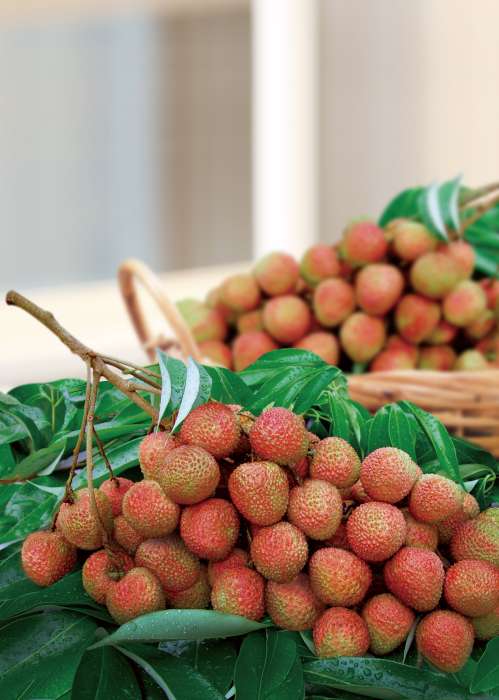
- Yu Her Pau Litchi The Charm of the Fruit Queen
Litchi was a fruit grown in the southern part of China. During the Tang Dynasty, in order to make Yang Guifei (one of the four beauties of ancient China) smile, Emperor Tang Minghuang commanded the officials to deliver litchis to the palace all the way from Lingnan, which was thousands of miles away. Thus in addition to its juicy and delicious taste, litchi is also romanticized with this thousand-year old legend. In particular, the variety of Yu Her Pau litchi has large fruit, thick flesh and a small pit. It is said that the litchi variety that won the smile of Yang Guifei was Yu Her Pau litchi. Therefore, Yu Her Pau litchi is also known as the “Smile of the Concubine.”
Litchi was described by the ancestors as having “fruit flesh as white as fat; is sweet and juicy.” Litchi not only is juicy and high in sweetness but also has indescribable plump and delicious fruit flesh. Among many different varieties of litchi, Yu Her Pau litchi has the plumpest flesh. The best time for tasting Yu Her Pau litchi is in the summer. There is a proverb spread among common people which says that “once litchi is up for sale, the rest of the fruits step down.” The Fruit Queen position of the litchi is clearly seen. The main growing areas are in the districts of Dashu, Cishan, Shanlin and Neimen.
After litchis are cut from the branches, it changes color on the first day, changes aroma on the second day, changes taste on the third day and loses all aroma and taste on the fourth day. Litchi does not have the effect of after-ripening. Therefore, for litchi, the higher the ripeness, the better the flavor! When purchasing litchis, large fruit with apparent protuberances should be a better selection. When litchi turns red and plump and the protuberances gradually turn smooth, it is the proper harvest ripeness of litchi. Litchi with 70% ripeness can be stored longer than the fully ripe litchi. The purchased litchis can be kept fresh for three to four weeks if packed in a plastic bag and immediately stored in the refrigerator with temperature of 4-5℃
The Mellow and Alluring Guifei Fruit
The varieties of Taiwan litchi include: Yu Her Pau, Heiye and Nuomizi. Growing areas are scattered in the regions of central and southern Taiwan. The major harvest season lasts from May to August annually. The fruit queen Yu Her Pau litchi is also known as the “Smile of the Concubine.” Under elaborate cultivation by the local growers, Taiwan has become one of the main litchi producers in the world, ranking second in production output only behind China. The annual harvest season of Yu Her Pau litchi only lasts from mid-May to mid-June, for a total of four weeks. The flesh of a fresh quality litchi is translucent and creamy with a milky white or yellow wax color and a mellow flavor. Due to the exquisite cultivation techniques of the fruit growers, it is quite a joy for people living in subtropical Taiwan to savor such a sweet and delicious fruit!
- Delicious dishes:Multi-grain Litchi Bread
- Ingredients
- Bread flour 220g
- Multi-grain flour 100g
- Sugar 15g
- Salt 5g
- Instant yeast 5g
- Water 200g
- Vegetable oil 20g
- Dried litchi Appropriate amount
- All kinds of grains and rolled oats Appropriate amount
- Cooking Method
Put all of the ingredients (except vegetable oil, grains and rolled oats) together and stir into a dough; add vegetable oil to it, mix and knead the dough until it can hold as a thin membrane when stretched; add dried litchi to the dough and knead the dough again; prepare a steel pan smeared with oil and put the dough in it; cover the pan with plastic wrap until it ferments and doubles in size (about 60 minutes). This completes the bread dough. Soak dried litchis in water or wine the night before. Roll the dough to give it a round shape and let it stand for another 20 to 30 minutes; then make the dough into an olive-shaped form and place it in a baking pan, let stand to ferment for another 15 to 20 minutes. When fermentation is completed, use a knife to cut some lines on the dough; spray water and sprinkle grains and rolled oats on the bread dough; and bake at 200℃ for 30 minutes. (The temperature should be adjusted according to the temperature difference of each oven. If the oven has both upper heat and bottom heat, the recommended setting is 200℃ for the upper heat and 180℃ for the bottom heat.)
- Applications of the Fruit
- Litchi juice
- Litchi jelly
- Candied Fruit
- Jam
- Liqueur
-350.jpg)